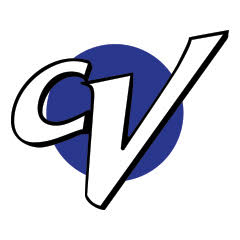a.k.a. How to Do Your First Time Trial
From time to time people ask what they need to start racing time trials on the road. So I thought that I would pick the brains of a couple of veterans and combine that with my thinking and produce a brief introduction to “Starting Your Time Trial Career!” Thanks to Hans Jorgensen and Paul Leek for contributing their thoughts as well.
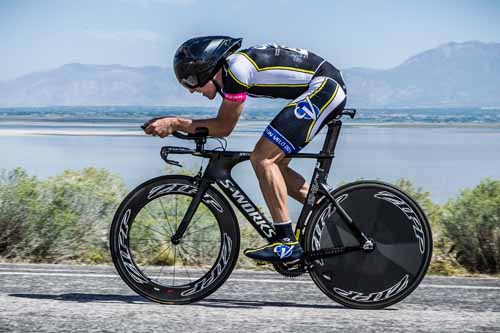 In my opinion, the first step to racing time trials is to decide you are going to do it! This step seems to be obvious, but for some, the prospect of pinning a number on their back and then having a time and a placing posted next to their name is daunting. Some just can’t do it. But you can! (Of course, make sure that you are medically able to compete before trying a TT!)
In my opinion, the first step to racing time trials is to decide you are going to do it! This step seems to be obvious, but for some, the prospect of pinning a number on their back and then having a time and a placing posted next to their name is daunting. Some just can’t do it. But you can! (Of course, make sure that you are medically able to compete before trying a TT!)
A logical next step is to pick a time trial that you plan to enter. Pick one that is far enough into the future so that you have time to prepare all that is necessary to race. Now when you do this, I recommend that you do not pick a major event like the State or National Championships to make your debut as a time trial rider. I have seen several do this and the result has not always been pretty. Rather, I recommend that you select one of the regular SoCal time trials, like Piru or Fiesta Island to get your start. These are run throughout the year so you can find one that fits your schedule. There is a nice one in Santiago Canyon as well, but it is now only run a couple of times a year.
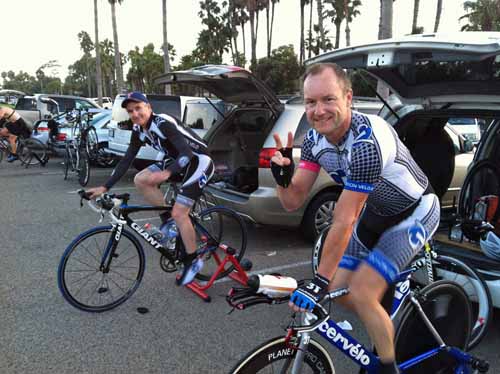 Another thing is that it is good to have someone else to go with, or at least who is going to be there at the race as well. It is always more fun to have a teammate along to warm-up with and to share in the racing experience. Sometimes it is more about the stories you tell afterwards than the actual racing itself! It is also very helpful if you can go along with an experienced racer and learn from them. That is how I did it and I found that to be really great way to go.
Another thing is that it is good to have someone else to go with, or at least who is going to be there at the race as well. It is always more fun to have a teammate along to warm-up with and to share in the racing experience. Sometimes it is more about the stories you tell afterwards than the actual racing itself! It is also very helpful if you can go along with an experienced racer and learn from them. That is how I did it and I found that to be really great way to go.
Once you have decided to do it and have picked out a race, preparation is now key. You need to prepare your body and your equipment for the race.
TT Equipment
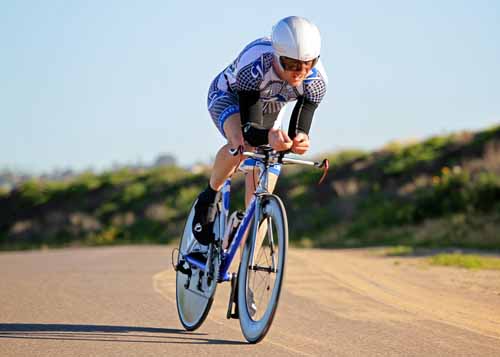 Let’s first talk equipment, i.e., what do you need to time trial? Of course, you can race a time trial on your road bike with your regular road kit and helmet, but you will be at a significant disadvantage against others using aero equipment.
Let’s first talk equipment, i.e., what do you need to time trial? Of course, you can race a time trial on your road bike with your regular road kit and helmet, but you will be at a significant disadvantage against others using aero equipment.
Aero equipment is costly, so unless you want to lay out the big change from the outset, I would say that it may be best for you to just ease into it by getting the fastest gear you can afford in order of what is most effective first.
So, with this in mind, below are my recommendations for upgrading your equipment for time trials, in ranked order, i.e., what to get first.
1) Aerobars: From my experience and from what I have learned, your position on the bike is the most important part of time-trialing. You have to get down and out of the wind. The most economical way to do this is to put clip-on aerobars onto your road bike. Of course, integrated aerobars on a TT bike are faster, but clip-on bars do the job. It really can’t be said enough, the most important equipment on any bike in a time trial are the aerobars.
2) Aero Helmet: Your head is a key part of the “leading edge” of your time trial presentation, so it is critical that this part cuts through the wind. You don’t want your road helmet acting like a parachute out front on a TT. To emphasize this point, I have even seen riders in a TT with plastic wrap all over their road helmet to eliminate the parachute effect of a regular helmet.
3) Aero Front Wheel: The absolute front of your “leading edge” is your front wheel. Aero wheels definitely make a substantial difference in reducing aerodynamic drag, and most particularly the front wheel. The fastest front wheels are the deeper dish wheels (80mm plus), but these can be difficult to use in a cross wind. 60mm wheels are good all around wheels, which is what I use. They are fast, but not too difficult in cross winds.
4) Skin Suit: The largest part of your time trial presentation is your body, so you want to cover it with something slick. A good skinsuit is much faster than the regular jersey/shorts combination.
5) Shoe Covers: Your shoes are another part of you that hits the wind head on. As a result, you want to get some skin over your shoes.
6) Aero Rear Wheel/Disc Wheel: The fastest wheel combination is a deeper dish front coupled with a disc rear. Disc wheels can be very expensive, but for beginners plastic disc covers for your road wheels are available and can provide the aerodynamics of a disc at a fraction of the cost of a disc wheel.
7) Aero TT Frame: Once all of the above is in place, the TT frame completes the picture. While a TT frame is more aerodynamic than a road bike, the fit of the frame and your position on it is the most important factor in the selection of a TT frameset. You can have a super aero frame, but if it doesn’t allow you to get into a position where you can deliver optimum power in an aero position, then it is not the frame for you. Another issue is there are frames that are legal for triathlons, but not for USAC time trials (they usually only check your bike and position at Nationals and the Worlds, but they can at any race), so make sure you get the frame that allows you to use it for the events you are interested in doing. Generally speaking, a TT frame is legal for triathlons, but not always the other way around.
8) Other “Little Things”: Time trialing success, beyond training, is dependent on the cumulative effect of many other little things which add up to time saved over the course of a race. Examples of these include shaved legs, having your arms covered or shaved, wearing aero gloves (or no gloves at all) instead of your usual non-aero gloves, having well maintained equipment, the right amount of air in your tires, etc.
Basic TT Training
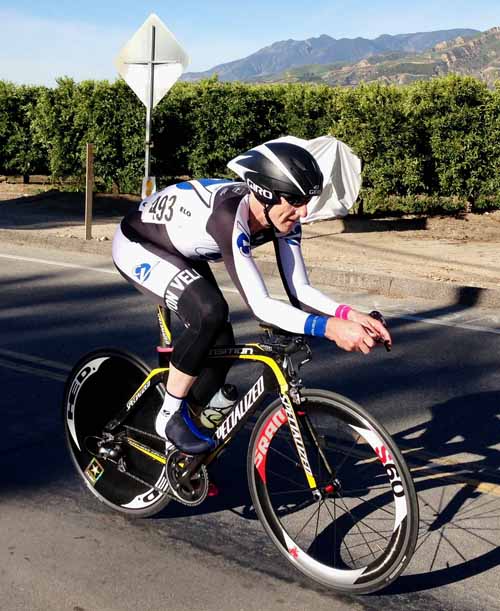 In preparing your body, you need to start with a base level of cycling fitness, but as a regular cyclist you already should have that. You can do a TT without specific training, just to see where you are, or you can train specifically. If you want to specifically train, keep in mind that a training plan is only going to make a difference over weeks and months, not days, so you will need to work at it over time. There are several training plans available on-line. Interval training is key to preparing for time trial efforts. I prefer shorter fast intervals with lots of repetition.
In preparing your body, you need to start with a base level of cycling fitness, but as a regular cyclist you already should have that. You can do a TT without specific training, just to see where you are, or you can train specifically. If you want to specifically train, keep in mind that a training plan is only going to make a difference over weeks and months, not days, so you will need to work at it over time. There are several training plans available on-line. Interval training is key to preparing for time trial efforts. I prefer shorter fast intervals with lots of repetition.
Hans suggested that an important part of preparing your body includes being fit properly for the optimum balance of aerodynamics with power. Some people may need time to eventually achieve an efficient position as they may initially have some limitations such as hamstring tightness or low back issues. Because of this it is recommended that you experiment with your position to find that right balance where you are aero but can also lay down consistent power.
As a follow up to the importance of the aero position, Hans again reminds us that it’s important to note that we use our muscles differently in the TT position than in a road bike position and need to train in that position to adapt. We have seen guys ride their TT bike for the first time at the State Championships, and after the race we see them limping around for an hour due to the pain in their non-adapted glutes.
As you prepare, you may want to do a couple of simulated TT efforts where you ride against the wind at speed for a considerable distance. When you do this, your effort level may come as a surprise to you. You should use this kind of effort as an opportunity to check your riding position while riding at full speed. Whatever your training plan, make sure you don’t over do it in the days just before the event. Your body needs to be given time to recover before you race.
Both Paul and Hans emphasize the importance of mental preparation and the expectation that you can learn some real lessons about yourself and about cycling as you race time trials. Think about being able to time trial so that once you make that critical break in a ride or road race you won’t get caught, think Fabian Cancellara or Tony Martin!
The Day before and the Day of the Race
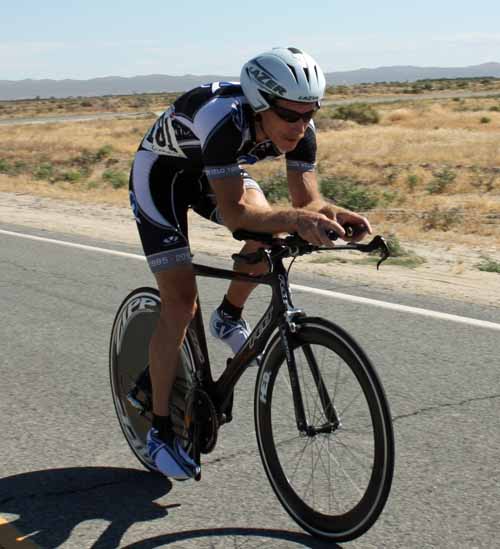 Hans taught me the importance of doing the little things on the day of the race. Below is how I go about approaching each race, and therefore what I would recommend that you do to get the most out of your time trial experience:
Hans taught me the importance of doing the little things on the day of the race. Below is how I go about approaching each race, and therefore what I would recommend that you do to get the most out of your time trial experience:
1) Do a leg opener ride the day before the race. For an important race, keep that leg opener ride brief and only go hard for a few minutes a couple of times to wake up the legs. Don’t over do it before an important race.
2) Use a checklist and pack up the car the night before. If you have ever seen someone get to a race, only to have forgotten his or her shoes, or some other critical piece of equipment, you won’t forget it.
3) Stick to your normal diet the day before and get a good night’s rest.
4) Leave home in time to arrive at the race at least two hours before race time. This will give you time to get a good parking spot, to set up your stationary trainer and your TT bike (I bring my road bike for the trainer so my TT bike is ready to go without any muss or fuss), go to the restroom, get your number, get your kit on, etc.
5) The first order of business once at the venue is to secure your car key if your car has one. I learned from Hans to put the car key on a string around the neck immediately upon arrival.
6) Get in a good warm-up, but not too hard. I use a 40-50 minute warm-up on my stationary trainer, the first 20-30 minutes is an easy spin, then two to three intervals to raise my heart rate to 150 each time, spinning fast so as not to build fatigue in the legs, with 2 minutes of easy spinning in between, and then 4-5 minutes of easy spin at the end.
7) Get off the trainer and secure the car/spare equipment with 15 minutes to go to your start time. Make sure you and your TT bike are all set to go.
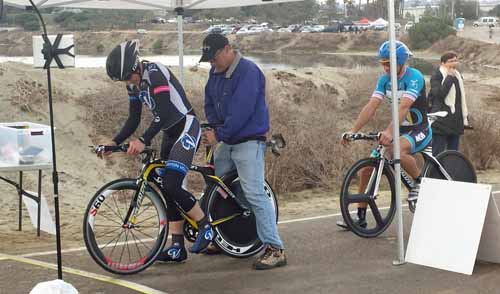 8) Don’t miss your start time. To make sure, you should ride over to the start area with 10 minutes to go.
8) Don’t miss your start time. To make sure, you should ride over to the start area with 10 minutes to go.
9) Enjoy the race.
10) After the race do a brief warm-down ride on the trainer or on the road.
That is it. There is not much more to it. Have fun!
